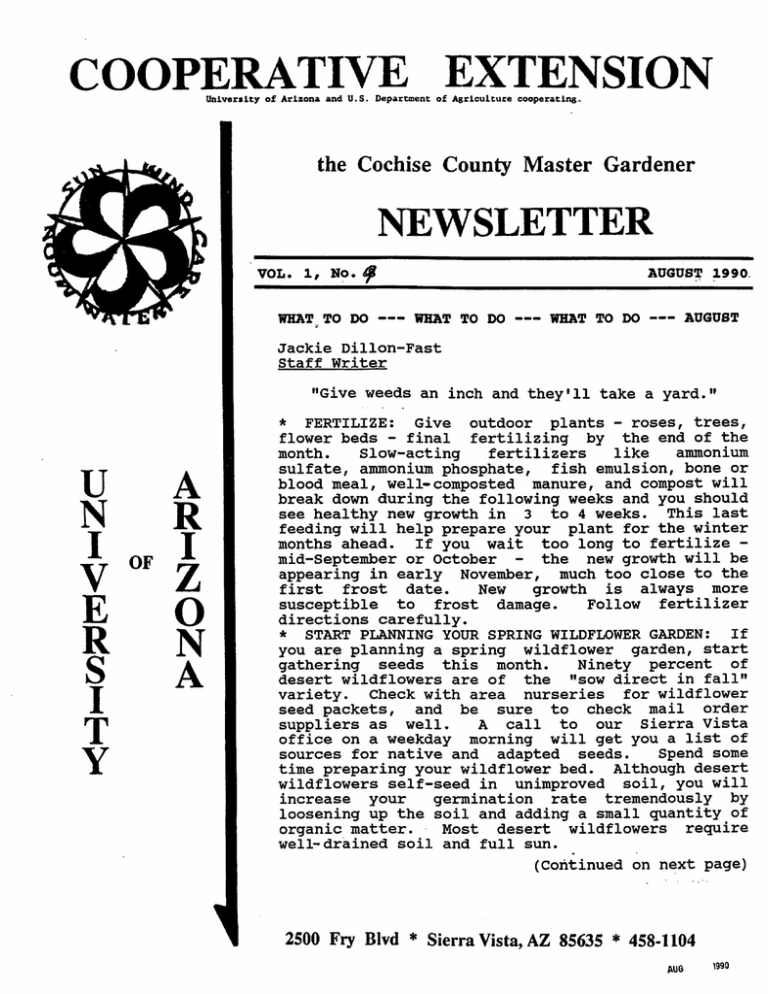COOPERATIVE EXTENSION NEWSLETTER
advertisement

COOPERATIVE EXTENSION University of Arizona and U.S. Department of Agriculture cooperating. the Cochise County Master Gardener NEWSLETTER VOL. No. AUGUST WHAT TO DO WHAT TO DO WHAT TO DO 1990 AUGUST Jackie Dillon-Fast Staff Writer "Give weeds an inch and they'll take a yard." * FERTILIZE: Give flower beds - final U N I V E R S I T Y OF A R I Z O N A outdoor plants - roses, trees, fertilizing by the end of the month. Slow-acting fertilizers like ammonium sulfate, ammonium phosphate, fish emulsion, bone or blood meal, well-composted manure, and compost will break down during the following weeks and you should see healthy new growth in 3 to 4 weeks. This last feeding will help prepare your plant for the winter months ahead. If you wait too long to fertilize mid-September or October - the new growth will be appearing in early November, much too close to the first frost date. New growth is always more susceptible to frost damage. Follow fertilizer directions carefully. * START PLANNING YOUR SPRING WILDFLOWER GARDEN: If you are planning a spring wildflower garden, start gathering seeds this month. Ninety percent of desert wildf lowers are of the "sow direct in fall" variety. Check with area nurseries for wildflower seed packets, and be sure to check mail order suppliers as well. A call to our Sierra Vista office on a weekday morning will get you a list of sources for native and adapted seeds. Spend some time preparing your wildflower bed. Although desert wildflowers self-seed in unimproved soil, you will increase your germination rate tremendously by loosening up the soil and adding a small quantity of organic matter. Most desert wildflowers require well-drained soil and full sun. (Continued on next page) 2500 Fry Blvd * Sierra Vista, AZ 85635 * 458-1104 AU6 1990 * WATCH FOR FICIENCIES: DE between leaf surfaces been leaf miner. small white Sucking insects or yellow spots NUTRIENT If you have fertilizing your gardens through the growing season, you should not be seeing deficiency symptoms. The following is a review of some common symptoms: NITROGEN - leaves are pale green or yellow throughout, lower leaves are older more or severely affected, top growth is stunted, leaves drop early; PHOSPHORUS leaves are reddish tinted, growth or slows, seeds fail to purple roots and develop, symptoms worsen in cooler weather; IRON - leaf veins are green but rest of leaf is yellow, newer leaves and ends of branches are severely affected; all yellowing tips may stay small and clusters of leaves though green, leaves are clustered, at ("pom-pom more ZINC - over ends foliage of effect"), branches much like iron deficiency in appearance. Severe iron and zinc deficiencies can be corrected quickly using a foliar spray. Make sure the iron is in the chelated form. * OTHER PROBLEMS Sunburn — large develop on tops TO WATCH FOR: white of spots leaves, indicates indicate presence of aphids, spi der mites, pers, plantbugs, etc. The leafhop most positive identification you can make is to find the offending bug on the damaged plant. When you see damage, look for the source before resorting to spectrum pesticide. a a specific pest, you to avoid killing the may be able "good guys" ladybird beetles, praying mantis, lacewings - along with the bad. * PROLONGING ANNUALS: Pinching off spent blossoms will encourage plants to continue flowering.^ It redirects plant energies flower production rather seed formation. You can cut back one-third their current height. Remember to give them some fertilizer growth. * to PLANT Plant fuel this COOL-SEASON cabbage, * PLZ^T COOL-SEASON SEEDS: Sow calendulas, starts at edges of leaves and starts at tips and works down. Overwatering - roots begin to rot, plant is wilted even if you give it around additional water, soil plant never dries, internal leaves yellow and drop. Texas root rot - attacks quickly, initially resembles sunburn, watch for white sporemat beneath tree, plant remain on diagnosis dead tions, pansies, Iceland snapdragons, and violas FLOWER carna poppies, for fall color. * STAY ONE WEEDS: each those STEP AHEAD OF YOUR When admiring your garden morning tiny overnight. keep weeds With pulling that all up pop the up rain we've been having, tiny weeds can become big problems very quickly. dies but leaves plant, positive requires examining roots under microscope. - chard, kale, lettuce, potatoes, spinach, turn brown. moves inward, on narrow leaves it new VEGIES: carrots, and turnips. - burning into than your spring planted tomatoes to encourage them to produce a fall crop. Cut them back to about usually in the center, which then Salt-burn wide- By targeting branch ends with cicadas brown CORRECTION leaves, look for chewing marks on the branches. Chewing insects random holes or skeletonized The telephone leaves Wertz, County Coordinator for the Global ReLeaf program should indicates beetles, whole leaf being consumed except veins indicates caterpillars, tunneling the June number newsletter listed for in Cathy have been 364-5477. AU6 1990 "A CHANCE TO GET SOME PLANTS" Jackie Dillon-Fast s t a f f Writer Without a doubt, fall is the best season for planting in the desert. Plants put in during September and October benefit from cool nights, mild days, and nine full months to develop a healthy, extensive root system before the hot, dry days of June come around again. Most of the beautiful desert wildflowers that grace our canyons and roadsides must be sown in the fall for spring bloom. Fall is also a marvelous time for hard-to-find native and adapted plants for your garden. a look at the wide variety of If you've never taken attractive available at some of the area plant for a treat and a surprise. Are the Definitely. But get there early! and hardy plants shows and sales, you're in shows/sales worth the trip? If you do find a few additions for your garden, try to have them earlier if it looks like we're in in the ground by mid-October, for a cold winter. And, don't plantings don't produce much top be surprised if your fall growth before the temperatures drop. They will be busy developing roots all winter and will reward you with healthy new growth and blooms next spring. Be sure to pick up a few packets of wildflower seeds - poppies, mallows, flax, vegetable beds. penstemons - to scatter in your flower or They will brighten many spring mornings. NEAR: Arizona Sonoran Road. Museum, 2021 Kinney Tucson. to be announced^. The Annual Harvest Celebration M Wildflowers pictured L to R (common names): Desert Mallow, Rocky Mt. Iris, Sego Lily, Tradescantia, Columbine, Thimble Berry, & Nightshade, W90 Tucson Botanical Gardens, 2150 N. Alvernon Way, Tucson. Saturday October 6 and Sunday October 7, 10:00 am to 4:00 pm. (Members-only sale 8:00 - 10:00 am.) "All of the plants the T.B.G. insures that they are offers pre-adapted destroy •imports* . . . Some are to are Arizona grown. native conditions This that would to the Sonoran desert, others to Australia and Africa where climatic conditions resemble ours." GET THERE EARLY! A BIT FARTHER AWAY: Boyce Thompson Arboretum, U.S. Highway 60, Superior, AZ (East of Phoenix). Saturday November 10 and Sunday November 11 (times to be announced but probably from 8:00 am to 4:00 pm) . The Fall Landscaping Festival will include educational booths, special arboretum tours, and an arid lands plant show and sale. (Don't neglect area nurseries. As demand for native and adapted plants increases so does availability. If your nursery doesn't carry what you want, ask them if they can get it.) or GIFTS FROM THE DESERT Carolyn Gruenhagen Staff Writer In a short time your prickly pear cactus fruits (seed pods) will be turning red, falling off, and generally becoming a mess. Why not pick them and make some cactus jelly and cactus juice it is not very hard, and they taste great! David Eppele, President of Succulent Arizona Research, Cactus & Inc., a botanical garden in Bisbee, AZ shares his recipes with us. To pick the tongs, and fruit, use be very because they have them. or Gather grocery kitchen careful tiny spines on and sack wash a of strain it through several thicknesses of cheesecloth. bucket the fruit. Any small spines, the seeds, and the skin will in the cloth. This makes great food for birds, remain pigs, or chickens, by the way. Now you have about a gallon of cactus juice. To make never-fail prickly pear jelly, boil 4 cups of juice along with a package of powered pectin. Add of sugar and bring You may add a little for an interesting 5 or 6 cups to a boil, lemon juice taste. the liquid into sterilized Pour jelly jars and seal them with melted paraffin or cap the jelly jars and put them in the freezer. That's all there is to it. When you send off your gifts to friends, stick in a jar of cactus jelly and they will be most Use the tongs to transfer the fruits into a large kettle, add grateful! about an inch of water, and cover. Boil the fruit gently To make cactus juice, store the pure juice of the prickly pear until i t is softened minutes. After it cook, mash with a - about 45 starts to potato masher to make sure each fruit is broken open. Continue cooking for another 10 minutes until all of the fruit is tender. Pour the fruit and juice into a cloth bag. fruit in freezer containers. At Arizona Cactus, the juice is frozen in plastic soda bottles. When ready to make the juice, thaw it, pour into a gallon jar, add 1/2 cup of lemon juice and three cups of sugar. Then fill the jar with water. Delicious! AU6 t9S0 so I9HAT>8 A ANYWAY? PART MASTER GARDENER II A NEW CLASS BEGINS? the Master Gardener program and some impressions of the program by a then brand-new Master Gardener. Jackie Dillon-Fast Proaram Coordinator WHAT IS A MASTER GARDENER? and foremost, A fall Master Gardener Class is is a a Master volunteer. The First Gardener volunteer being offered beginning Thursday, September 6. The class will meet every Thursday from 6:00 - 9:00 portion of the program provides support for the community and personal opportunities for the pm for ten weeks, with optional field trips every Friday. Since volunteer. each class covers subject area, an entire attendance at all Master Gardeners staff the Sierra Vista Coop erative Extension Office, produce the Master Gardener Newsletter, of Arizona and Cooperative Extension specialists, as well as and participate in community activities such as the Douglas 4H Mini-Fair and the Amazing Arizona Mini-Festival. Our goal is to provide basic gardening infor area mation ten classes is required. Classes are taught gardeners, by University and emphasize urban horticulture in the desert environment. Master Gardeners pay $25 for large class binder information) final exam to Master materials packed and must pass a be certified as a Gardener. Since size is limited to Master (a with Gardeners class 25, potential are asked to to Cochise County gardeners and to coordinate with other county, state, and national programs to bring urban horticultural Cochise especially resources County. important into We to are the program right now since Cochise County is minus one Agriculture Extension Agent. fill out an application outlining their interests and experience. Whereas some gardening experience is needed, enthusiasm and commitment are more the program. essential to WHY DO PEOPLE GARDENERS? starting accepted will be available If you're not sure if the Master Gardener Program is for you, the following answers may help you decide. If after reading through them, you still have (juestions about the Master Gardener Program, please call me at the Sierra (458-1104) any Vista your issue the benefits Wednesday Gardener Because Program Gardener the Master is part of the Cooperative Extension Service under the University of Arizona, we have access to many horti culture and agriculture spe cialists. Specialists in soil science, entomology, plant path ology, water management, vege table, fruit and nut crops, Office native plants, etc. provide us with the initial training and are after available to us for noon from 1:00 to 4:00 pm or drop me a note. TO BE MASTER i n i t i a l ten week Master Monday, August 20, and through Wednesday, August 29. of of being a Master Gardener is the training we are given in the Class. Applications WANT One follow-up or advanced training. If you've been saving Newsletters, (December quick overview of our 1989) premiere gave a the history of WHAT ARE OF? Some program MASTER of us having GARDENERS come MADE into the years AUG of 1990 experience in horticulture? of us are gardening. or newcomers soin© desert Some of us have jobs businesses horticulture? connected some plot out back. full and homemakers, to with of us have a We are retired, part-time school workers, teachers, landscapers, computer experts, artists, and engineers. At the end of our ten weeks of basic horticultural training, tainly don't know status, meaning we do not want to be contacted about upcoming Master Gardener continue to benefit you. the information they need. will improve the lawn by allowing HOW MUCH TIME water to IT find REQUIRE? One of the major volunteer efforts is staffing the Sierra Vista office weekday mornings. Whenever possible. Master Gard eners are requested to ^put in 30 hours answering questions at the office. Master with full time jobs Gardeners or other conflicts may volunteer this time in other ways. In addition, an other 20 hours are volunteered to design a gardening project (this us for apply example) that what we|ve learned, gives us the opportunity to use new or existing skills, and makes a contribution to the gardening community• A total of 50 volunteer hours are required. There are as many ways of making this contribution gardeners in as the there are program. Projects usually begin soon after the training and everything help non-Master Gardeners newsletter from we cer CUTTINGS helps or contribute to the gardening community. At the end of your year, the decision will be up to there is to know about gardening, but we are better eguippod to handle our own gardens and to DOES activities training. Some of us move on to other things after one year, others stay with the program and ends and created, designed, and mented by each individual are imple so the size and scope is determined by the Master Gardener and the Program Coordinator. DOES IT LAST FOREVER? At the end of our first year as a Master Gardener, we can remain active in the program or go on inactive * 'N* CLIPPINGS Occasional use penetrate of an aerator health of your air, food, and more easily. Golfers have been known to aerate their lawns by walking on them in their golf shoes. (We didn't test this one to see i f i t works. Those shoes would have to have some hefty spikes to make deep enough holes.) * An option for controlling those pesky weeds growing in the cracks in your patio, sidewalk, or driveway: repeated appli cations of boiling water will kill the top growth and possibly the root system as well. didn't test this one (OK, we Master Gardeners don't get weeds, right?) f=r2> Co staff: Thomas Christian Jackie Dillon-Fast Carolyn Gruenhagen Rose V. Land Merrianne Lange T.J. j either - Martin Articles to be published in next month's newsletter must be received at the Sierra Vista Extension Office no later than August 24. AUti 1990 • WHAT'S BUGGING YOU? by T.J. Martin GRASSHOPPER CONTROL FOR THE HOME GARDEN COMMON NAME: Grasshopper, Locust, or @1*%+$!. SCIENTIFIC NAME: Acrididae. DESCRIPTION: Adults These insects range from very small to over three inches in length and appear to be "armor-plated". The antennae are short, the mouthparts prominent and the hind legs are enlarged for great jumping power. The wings are three inches in length. Colors yellow, or multi-colored. well-developed include black, and can be up to brown, red, green, Nvmphs - These are simply smaller versions of the adults but without wings or with very short wing-st\ibs as they mature. Eggs - The rice-shaped, yellow or cream-colored eggs are laid in soil or weeds. The eggs are surrounded by a hardened jelly-like substance and the clusters can contain up to 75 eggs in one "pod". LIFE CYCLE: The eggs hatch in late spring or early summer (April June). The young nymphs feed voraciously on just about anything they can find. When they have grown to their adult size and have developed wings, they then fly to find new food sources. These pests feed by day and spend the nights in tall weeds or shrubs. They can also be found on fence posts or the sides mate and the females lay clusters the soil. buildings. In late summer they eggs up to three inches deep in There is only one generation per year. PLANTS USUALLY AFFECTED: TIME OF YEAR: of of Almost all garden and field crops. From April until frost (usually late October) . They become more visible when they are full grown and can fly to new areas. Large numbers of these pests can be seen in Cochise County in August and September. WHAT TO LOOK FOR: crops. Grasshoppers They eat holes in the chunks out of the side of the cause general, all-round damage to middle of leaves, foliage or just eat the entire plant, chew large jagged leaves, stems and all! As you walk through your garden or move the foliage with your hands, they will jump or fly to get away from you. PROBLEMS AND DAMAGE: Besides the general loss of foliage through voracious feeding, the grasshoppers chew right through leaves and stems and can cause large portions of a plant to fall to the ground. CULTURAL CONTROLS: While it probably won't help with this year's pest problem, good cultural practices can go a long way toward decreasing next year's grasshopper population. Females prefer to lay their eggs in dry, undisturbed areas. Tilling the ground in the fall will discourage egg laying as well as uncover already deposited eggs and expose them to the weather and predators. Keep ground litter cleared away and mow any stands of weeds as these areas offer food and cover for the grasshopper population. Get your neighbor to keep his weeds cut down also. Cultivate the ground again in the spring to expose any eggs that you may have missed in the fall. A heavy application of compost or mulch can prevent the emergence of many young in the spring. COMPANION PLANTING AND REPELLENTS: Grasshoppers reportedly dislike onions, garlic, and hot peppers. So, make up a "tea" of one or more of these, add a bit of pure liquid soap to help it adhere, and spray it on your plants. MECHANICAL CONTROLS, BARRIERS, AND walk among your plants, or use your TRAPS: Check your garden often, hands to move the foliage. This will cause the 'hoppers to jump or fly where you can see them. Hand picking is easiest in the early AM when the pest is cold and moves slower. Keeping your plants covered with an agricultural fleece product, netting, or cheesecloth will keep the 'hoppers away from your plants. up. Remove only for pollination An effective grasshopper bait or when the heat starts to build can be made from 1 part molasses and 9 parts water. Half fill quart jars with the solution and sink into the ground up to the neck. Check daily and remove the dead insects. NATURAL CONTROLS: Grasshoppers make a tasty meial for spiders, mantids, ground beetles, blister beetles, Tachinid flies. Robber flies, and some parasitic nematodes. Red mites feed on all stages while snakes, skunks, toads, coyotes, ground squirrels, and field mice eagerly pursue the adults and nymphs. Neosema locustae is a commercially available protozoan parasite, but don't expect very quick results. Birds of all kinds get rid many gardeners keep a small flock of of grasshoppers much faster and chickens, ducks, guinea fowl, or even peacocks and allow them to patrol the garden for pests. BIOLOGICAL INSECTICIDES: Sabadilla dust is effective for control of common grasshoppers. Its effects are not long-lasting and it would have to be applied frequently for continued control. Apply in the evening as it also affects bees. CHEMICAL CONTROLS: Call your County current recommendations. Check at or nursery to see what they have Extension Agent or her staff for your favorite garden supply store available. Remember to check the label to make sure that the grasshopper is a listed target pest and FOLLOW THE DIRECTIONS EXACTLY! When it comes to pesticides, more is NOT better!! Wear protective clothing, watch out for non-target plants, pets, children, and other living things. Wash your skin and clothing after application and take care not to get the substance into your eyes, mouth, or breathing passages.





